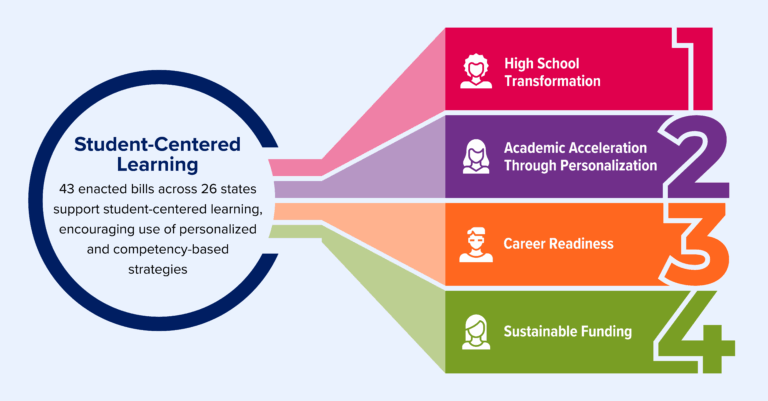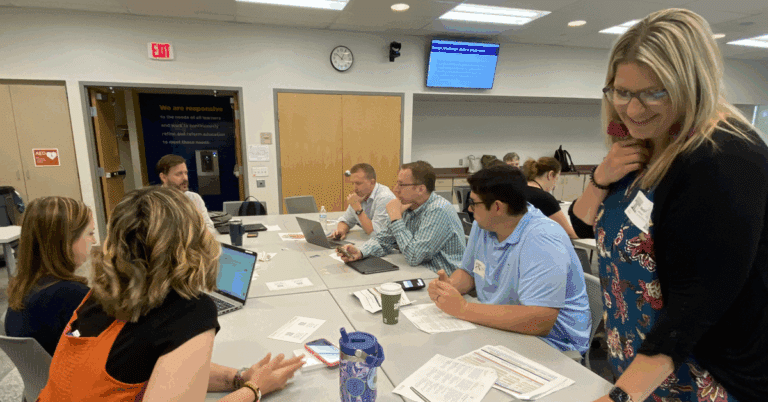By Amber Garrison Duncan, executive vice president of Competency-Based Education Network (C-BEN)
Education and business leaders face a critical juncture that requires a redesign of traditional educational structures, particularly the way we measure students’ learning and skills.
Since the early 1900’s, students’ learning is typically measured by the amount of time spent studying a subject, often referred to as the Carnegie unit or credit hour. Unfortunately, this practice does not measure the application of content learned, accelerate learning, nor equip students for college or career success.
Nearly 9.8 million jobs remain vacant and employers struggle to find qualified individuals with the skills necessary to fill these positions. While some experts suggest it’s mathematically impossible to fill every position, there is an untapped pool of potential that could benefit from obtaining the right competencies and skills to meet current workforce needs. Over 40 million Americans have some college experience but no credential. These former students are left without a formalized way to translate their skills for career attainment or advancement. At the same time, far too many college graduates are unable to demonstrate mastery of content or apply relevant skills in their careers.
It is time to disrupt this increasing skills gap in order to improve career outcomes for students, especially for women, Black and Latino learners who experience racial and gender inequalities in the labor market.
What K-12 needs to know
Competency-based education (CBE) is a proven model that accelerates learning by building on students’ skills and focuses on the competencies they need for success in today’s workforce. Positioning competencies as the currency of learning allows programs to evaluate the whole student and their skills to be great critical thinkers, contributors, or leaders within their professions. CBE assessments help create a personalized learning experience designed to help students develop in their unique areas of improvement. Many CBE programs span credential types and are implemented in an array of disciplines ranging from welding, general education, theology and medicine.
As we approach the 10th anniversary of the very first CBE assessment approval, there are nearly 1,000 CBE programs offered at 600 higher education institutions. More college and university leaders are turning to CBE to equitably improve opportunities for students to learn skills necessary to succeed in the current workforce. Increasing interest in CBE learning is generating anticipation of a second growth wave of new CBE programs. To further illustrate the widespread interest, the Carnegie Foundation for the Advancement of Teaching, who created the credit hour system, recently announced a partnership with Educational Testing Services (ETS) to develop a suite of CBE assessment and analytic tools to assess skills required for students to succeed in K-12, college and careers.
Why K-12 and higher education should collaborate on CBE
This junction ushers in a unique opportunity to create coherence with K-12 and higher education, two systems historically built to work disparate from each other. Students suffer because of the misalignment and disjointed policies and practices between the two sectors. Nonetheless, we have this moment to collectively and intentionally redesign the assessment of learning for the first time in this country’s history. Similarly to what’s occurring in the higher education space, K-12 leaders also invest in college and career preparation and seek more opportunities for quality learning and ways to serve more diverse learning populations.
Competency-based assessment is key, but the solution we are trying to determine is how to make quality CBE assessments more standardized. There’s much to learn from K-12 on assessment design, and there are willing partners in the CBE community who want to collaborate and compare practices to create standardized CBE assessments and programs.
How to collaborate
A transition of this magnitude requires a methodical and collaborative process in order to successfully scale and accelerate the adoption of CBE learning and programs across the entire education to career ecosystem. CompetencyXChange, an initiative to empower communities to systemically make competency the currency of learning, provides an action agenda to accelerate and scale the adoption of competency-based learning. Higher education, K-12 and industry leaders can leverage the CompetencyXChange tools and design principles to establish a vision, collective voice and clear strategies to scale competency-based solutions that are relevant and widely accepted.
It is critical that we work closer together to achieve the following:
- Establish cross-sector communities of practice where people can learn from each other, collaborate on strategies and ensure continuous improvement
- Standardize quality CBE assessments that equitably measure competencies students need for college and career success
- Create synergy between industry needs and the professional development of teacher preparation programs, current educators and higher education professionals
- Develop new pathways between K-12 and higher education by using competency-based learning and assessments to enhance equity in college admissions and enrollment, dual-enrollment and other early postsecondary opportunities to accelerate beyond the 12th
The shift to competency-based learning is gaining momentum, and educators in K-12 and higher education have an opportunity to inform the future direction of this work. Let’s work together to ensure future students have seamless transitions and quality opportunities to gain and apply skills that can transform their college and career outlook.
Amber Garrison Duncan
Executive Vice President, Competency-Based Education Network
Amber has led work in competency-based education, learning frameworks, assessment, credential recognition, digital learner records, and open data standards, as well as quality assurance. Before her role at C-BEN, Amber spent eight years as a grant maker at Lumina Foundation and prior to that served as Director of Student Affairs Assessment and Research at the University of Oregon, and various student affairs roles at Florida State University, University of Michigan, Hope College and Texas A&M University.





